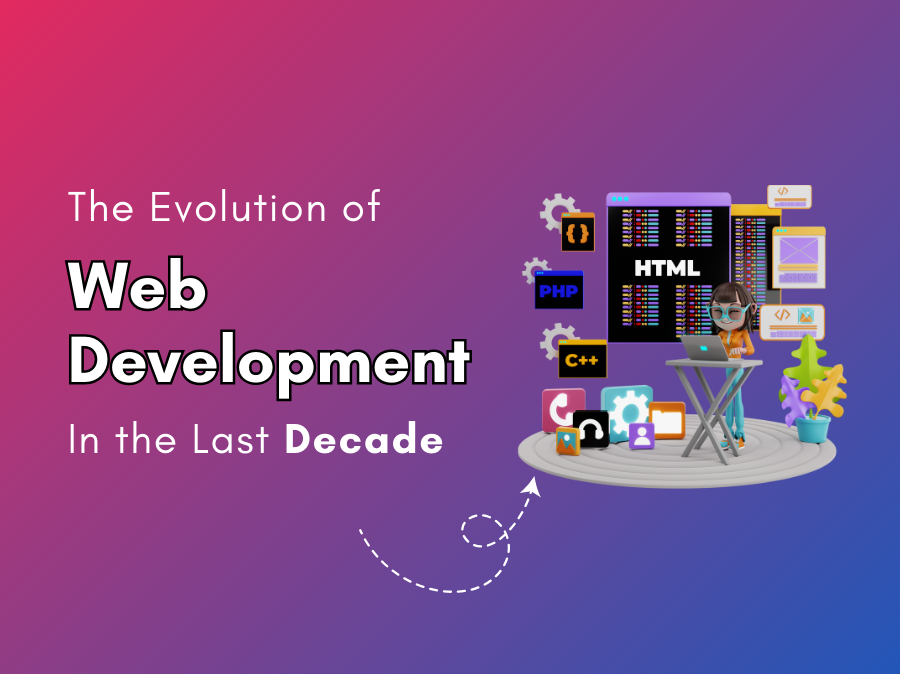A Decade of Change in Web Development
The last ten years have been nothing short of transformative for web development. A decade ago, websites were mostly static, mobile browsing was still finding its feet, and terms like “serverless” or “micro-frontends” were niche topics.
Today, the web is faster, more interactive, and deeply integrated into daily life. This rapid evolution has been fueled by advancements in technology, changing user expectations, and the ever-growing demand for speed and accessibility.
How the Web Looked 10 Years Ago
- Static, HTML-heavy pages dominated the landscape.
- CSS3 and HTML5 were still fresh innovations.
- Mobile browsing existed, but responsive design was rare.
- Content Management Systems (CMS) like WordPress were growing but not as feature-rich as today.
Key Drivers of Change in Technology
- The explosion of mobile devices.
- Cloud computing becoming mainstream.
- The rise of open-source communities and frameworks.
- Faster internet speeds and widespread broadband availability.
The Shift from Static to Dynamic Websites
Static sites once ruled the web — fast to load but limited in functionality. Over the years, dynamic websites have taken over, enabling real-time updates, interactive content, and user personalization.
Rise of CMS Platforms like WordPress
WordPress evolved from a simple blogging tool into a full-fledged CMS powering over 40% of the web. With thousands of plugins and themes, it empowered non-developers to build professional sites without deep coding knowledge.
Premium multipurpose theme providers like FoxThemes have taken this further, offering niche-specific, responsive designs that keep pace with modern development trends.
JavaScript Frameworks Taking Over
Frameworks like React, Angular, and Vue redefined how we build interfaces, allowing for lightning-fast single-page applications (SPAs) with smooth user experiences.
Mobile-First and Responsive Design Revolution
By 2016, mobile traffic overtook desktop, forcing developers to rethink design priorities.
Impact of Smartphones on UI/UX
Touch-friendly interfaces, larger buttons, and simplified layouts became the standard. Websites that didn’t adapt quickly lost users.
Adaptive vs. Responsive Approaches
- Adaptive design: Predefined layouts for specific screen sizes.
- Responsive design: Flexible layouts that adapt fluidly to any screen.
Responsive design, powered by CSS media queries, became the norm.
Advancements in Frontend Technologies
Frontend development saw some of the biggest changes over the decade.
React, Vue, Angular – The Big Three
These JavaScript frameworks became the go-to tools for building interactive, component-driven user interfaces.
CSS Grid, Flexbox, and Modern Styling Tools
- Flexbox simplified vertical and horizontal alignment.
- CSS Grid made complex layouts easier.
- Tools like SASS, Tailwind CSS, and PostCSS accelerated styling workflows.
Backend Evolution and New Architectures
On the server side, monolithic architectures began giving way to more modular solutions.
Microservices Replacing Monolithic Systems
Microservices allowed developers to break applications into smaller, manageable services that could be developed and deployed independently.
Serverless Computing and APIs
Serverless platforms like AWS Lambda and Azure Functions reduced infrastructure headaches while APIs connected services seamlessly.
The Role of Cloud and Edge Computing
Cloud computing became the foundation of modern web development.
Faster Deployment and Scalability
Platforms like AWS, Google Cloud, and Azure enabled rapid scaling and global deployment.
Content Delivery Improvements
Content Delivery Networks (CDNs) like Cloudflare and Akamai moved content closer to users, drastically reducing latency.
Emergence of Progressive Web Apps (PWAs)
PWAs blurred the line between web and native apps.
Offline Capabilities and App-Like Experiences
Service Workers enabled offline functionality, push notifications, and background syncing.
Benefits Over Native Mobile Apps
No app store dependency, smaller sizes, and instant updates made PWAs a cost-effective alternative.
Focus on Web Performance and Core Web Vitals
Google’s ranking algorithms pushed developers to optimize speed and usability.
Google’s Influence on Speed Optimization
Core Web Vitals — LCP, FID, CLS — became crucial ranking factors.
Tools and Techniques for Better Performance
- Lazy loading images
- Image compression (WebP, AVIF)
- Code splitting and minification
Rise of No-Code/Low-Code Platforms
Not everyone needs to write code to build apps anymore.
Democratizing Web Development
Platforms like Webflow, Bubble, and Wix allow non-developers to build functional websites quickly.
Benefits and Limitations
- Pros: Fast, cost-effective, user-friendly.
- Cons: Limited customization, potential vendor lock-in.
Security and Privacy in Modern Web Development
With great connectivity comes great responsibility.
Increased Threats and Data Regulations (GDPR, CCPA)
Data breaches became more frequent, prompting stricter global privacy laws.
Best Practices for Secure Development
- HTTPS everywhere
- Strong authentication systems
- Regular vulnerability testing
The Future – What’s Next for Web Development
The next decade promises even more exciting transformations.
AI-Assisted Coding
AI tools like GitHub Copilot and ChatGPT’s code suggestions are already speeding up development.
3D Web Experiences and WebXR
Virtual reality (VR) and augmented reality (AR) will bring immersive 3D experiences to browsers.
Lessons from the Last Decade
If there’s one thing the past decade has taught us, it’s that web development never stands still. Developers must stay adaptable, continually learning and experimenting.
What Developers Can Learn
- Embrace new tools, but master the fundamentals.
- Prioritize user experience over trends.
Adapting to the Next Wave of Changes
With AI, edge computing, and immersive technologies on the horizon, those who keep learning will shape the next evolution of the web.
